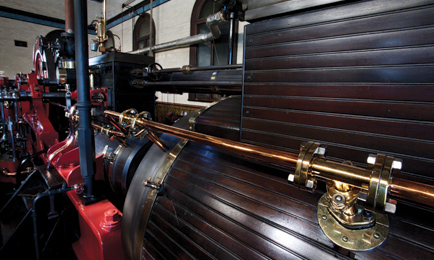Articles
Cambridge made: Headley mill engine from the mid-19th century
Cambridge is well known for its colleges founded in the 13th century, and for the tranquil River Cam where tourists and students enjoy leisurely punts through the heart of the picturesque city. But in the late 19th century there was nothing charming about the Cam, which reeked of untreated sewage.
The Victorians attempted to remedy this pungent problem by repairing, and even replacing, a network of overused and collapsing sewers. In 1894 they settled on a more comprehensive solution – building a steam station to pump the sewage to a farm at Milton, two miles away. The resulting Cheddars Lane pumping station continued to do its bit for city cleanliness by means of steam, internal combustion and electricity until 1968 when it closed down.
Today the pumping station is home to the Cambridge Museum of Technology and its collection of original equipment such as engines and boilers, some in working order and some being restored.
In the main engine-house, two grandiose Hathorn Davey steam engines, the only ones of their kind left in the world, can be seen. The engines, which pumped sewage and rain water from a well under the engines to Milton, continued working right up until the station closed down.
 This Hathorn Davey pumping engine comes to life on the museum’s steam days
This Hathorn Davey pumping engine comes to life on the museum’s steam days
Nearby are several other steam engines, such as a Mumford engine used to pump feed water back into the boiler and a Crompton and Parkinson engine which generated electricity to power lights in the pumping station.
In 1909, as Cambridge expanded in size and population, two large 94hp (70.1kW) National gas engines were installed to help with increased pumping demand. These mighty additions to the station, now located in the gas-house, pumped flood water into storage tanks after heavy rainfall.
Meanwhile, standing tall in the boiler-house is an ornate coke-fired boiler by Babcock and Wilcox, originally installed in 1923.
A decade later, a Crompton Parkinson electric pump was installed. This pump – used to cope with increasing storm surges from the new housing estates – perches proudly in the electric room.
Various other electrical equipment can be seen here, too, including electronic recorders, portable dynamos, dial thermometers, scale indicators and rocking microtomes – most of which were made by the Cambridge Instrument Company. A telephone switchboard from the 1950s, and a 1923 Ericsson telephone set retrieved from a whaling station in the Falklands, can also be spotted among the collection.
Further exhibits can be found on the upper levels of the museum, including a large Headley mill engine built in Cambridge in the 19th century and a steam-driven tar pump. Not to be missed is the letterpress printing exhibition where visitors can discover everything they need to know about the process of making type, and even print their own souvenir.
To see the engines and boilers at their best, it’s worth visiting the museum on a steam day.